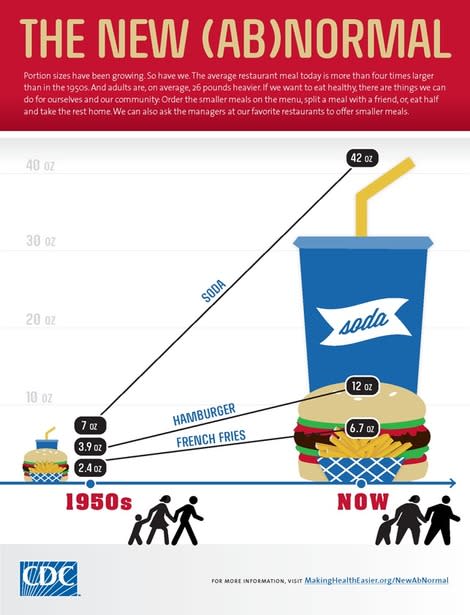CDC Infographic Shows Super-sized Portions Are the New Normal

In the mid-2000s, researcher Cornell researcher Brain Wasink performed an experiment called the "bottomless bowl of soup." He gave unsuspecting diners self-filling bowls of tomato soup to see how they would naturally regulate how much they consumed. On average, they ate 73% more than control subjects with normal bowls. Humans aren't good at saying no to food. And that tendency to mindlessly keep eating when provided with super-sized portions has some serious health consequences.
Related: Nearly Half of All Americans Will be Obese in 2030
The Center for Disease Control's (CDC) new infographic, "The New (Ab)Normal," makes clear how the increase in portion sizes over the 50 years has corresponded to America's ever-expanding waistline. The average American is twenty-six pounds heavier than in 1950. About one-third of us are overweight or obese and that number is projected to hit nearly 50% by 2030. At the same time, the size of a hamburger has tripled, a basket of fries more than doubled, and the average soda has grown from a modest 7 ounces to a jumbo 42 ounces.
Related: Obese Teens Can Have Heart Damage without Showing Signs
A 2009 study of chain restaurants shows that 96% of the entrees served exceeded U.S. Department of Agriculture (USDA) recommendations for calories, sodium, and fat. The CDC says the average restaurant meal is also four times larger than it was in the 1950s. Looking at these statistics, it's not surprising that eating only one fast food meal a week is associated with overweight and obesity.
Related: The Best and Worst Fast Food Muffins
We'd all like to eat healthy, home cooked meals, but sometimes that's not realistic. When you are eating out, especially at a chain or fast food restaurants, the CDC recommends splitting your meal with a companion or taking half home, or ordering the smallest size entrée on the menu available. They also encourage patrons to ask restaurant managers to provide smaller portions.
When trying to visually estimate appropriate portion size, the following comparisons can be helpful: A healthy serving of fruit vegetables is about the size of a baseball, a serving of meat should be about the size of a deck of cards, a serving of rice is about the size of a light bulb, a serving of fat, such as butter or mayo, should be no larger than a poker chip.
Also on Shine:
